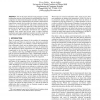Free Online Productivity Tools
i2Speak
i2Symbol
i2OCR
iTex2Img
iWeb2Print
iWeb2Shot
i2Type
iPdf2Split
iPdf2Merge
i2Bopomofo
i2Arabic
i2Style
i2Image
i2PDF
iLatex2Rtf
Sci2ools
MM
1994
ACM
1994
ACM
Two-Dimensional Scaling Techniques for Adaptive, Rate-Based Transmission Control of Live Audio and Video Streams
: One of the major obstacles facing designers of video conferencing systems is the problem of ameliorating the effects of congestion on interconnected packet-switched networks that do not support real-time communication. We present a framework for transmission control that describes the current network environment as a set of sustainable bit and packet transmission-rate combinations and show that adaptively scaling both the bit and packet-rate of the audio and video streams can reduce the impact of congestion. We empirically demonstrate the validity of adapting both packet and bit-rate using a simple feedback mechanism and simple adaptation heuristics to deliver audio and video streams suitable for low-latency, high-fidelity playout.
Interconnected Packet-switched Networks | MM 1994 | Multimedia | Obstacles Facing Designers | Video Streams |
| Added | 10 Aug 2010 |
| Updated | 10 Aug 2010 |
| Type | Conference |
| Year | 1994 |
| Where | MM |
| Authors | Terry Talley, Kevin Jeffay |
Comments (0)

